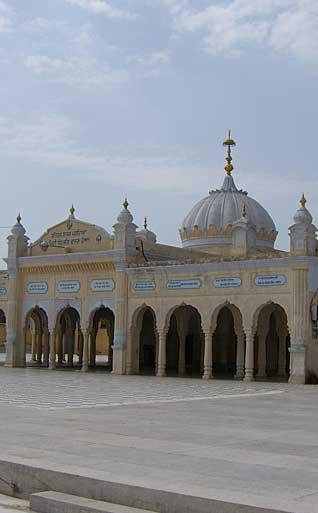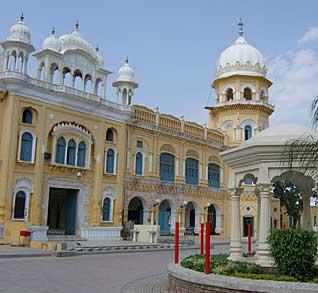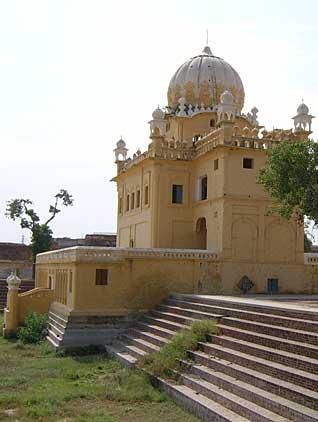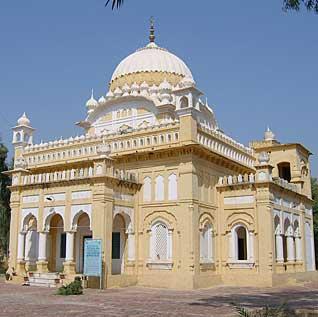History
The Land of Nanak
by NAVEEN S. GAREWAL
Blessed by Baba Nanak, the descendants of Rai Bular of Talwandi (now Nankana Sahib) have been a shining example of Sikh-Muslim brotherhood for over half a millennium.
Rai Bular, a contemporary of Guru Nanak and a devout Muslim, became his second known disciple. After Bibi Nanaki, Guru Nanak's sister, he was the next person to recognize that the young Nanak was no ordinary mortal and that he was a divine soul.
Sakhis (biographical stories) pertaining to the life of Guru Nanak, repeatedly refer to Rai Bular. In the story, for example, where villagers are furious about Nanak's cattle grazing on their crops, it is Rai Bular, the local landlord and chief of the village, who has the crop surveyed and reveals it to be miraculously undamaged.
In yet another sakhi, Rai Bular is said to have spotted a hooded cobra providing shade to a sleeping Nanak. This strengthened his belief that the child was no ordinary mortal.
The blessings that the family - known as the "Bhattis" - received as a result have, in turn - they believe - showered them with prosperity through nineteen generations to date, over the course of five centuries.
Today when the world is getting further divided on religious lines, the children of Rai Bular continue to carry on the tradition of the clan.
An important functionary of the now defunct Nankana Sahib Foundation, the late Rai Bashir, worked hard to build an institution on the ten acres donated by his nephews, Rai Sarwar Khan and Rai Ahmed Khan. He laid the foundation stone of the complex in June 1994.
Even though today, Rai Bular's family is scattered all across the world, his descendants are actively involved in the promotion of Sikh-Muslim unity.
The family has kept alive their ancestral links with the Gurus. Despite being devout Muslims, the family has maintained its emotional and spiritual attachment with Sikhism for the past several generations, building on the fact that Guru Granth Sahib has repeated references to Rai Bular.
His descendants now make special efforts to participate in all Sikh celebrations. For example, they took part in the tercentenary celebrations of the birth of the Khalsa at Anandpur Sahib in 1999.
They are bestowed the honour of leading the religious processions held at Nankana Sahib each year to celebrate the birth anniversary of Guru Nanak.
According to historians, Rai Bular was a contemporary of Nanak and the ruler of the area known as Rai Bhoe di Talwandi, within which Nankana Sahib is currently located.
Mehta Kalu (Kalyan Das), a well-read resident of the village, was an employee of Rai Bular. Nanak was born to Mehta Kalu and his wife, Tripata, in 1469.
According to the historical revenue records now in possession of the family, Rai Bular gave 247 marabbas of land to build a gurdwara to mark Nanak's birth-place (Janam Asthan), along with an annual jagir (stipend) of Rs 9996. [One marabba is equivalent to approx. 25 acres of land.]
He also gave another 220 marabbas for building another gurdwara (Bal Lila)to mark the place where Nanak played as a child; an annual jagir of Rs 31 was allotted to it.
Another 290 marabbas and an annual grant of Rs 50 was given for the Gurdwara Mal Sahib.
Thus, the entire land of Nanakana Sahib given to the followers of Guru Nanak by Rai Bular amounts to 757 marabbas (approx. 18,750 acres) and is now controlled by the Evacuee Trust Property Board of Pakistan and leased out to the people of Nankana Sahib.
Rai Bular chose to give his most fertile agricultural lands to Guru Nanak's mission after he became privy to the latter's divine powers. It is on this land, marking the precise spot where Mehta Kalu and Tripata's home stood and where Nanak was born, that Gurdwara Janam Asthan was built on the orders of Maharaja Ranjit Singh.
Incidentally, it is said that the Maharaja hailed from same lineage as Rai Bular, the former tracing his descent from Raja Rai Bhuni Khan - a detail recorded in Tarik-e-Bhattian, a chronicle of the Bhatti family.
Today, the Nankana Sahib Estate consists of about 16,962 acres, mainly leased to farmers and residents of Nankana Sahib. Almost all houses in the town of Nankana Sahib are built on the property.
"Babaji" (as Guru Nanak is still referred to locally in affectionate reverence), says Rai Mohammad Saleem Akram Bhatti, the 19th generation descendant of Rai Bular, "is revered by all of us as our father."
The family has directly been involved in managing the property from the time of Guru Nanak, through the successive heads of the clan.
The father-son duo, Rai Rehmat Khan and Rai Anayat, collected the revenue after the cataclysmic Partition of Punjab, and deposited it with the Gurdwara Management, which then applied it for the upkeep of the seven historical gurdwaras which grace the region.
The family of Rai Bular has maintained the lofty traditions of its most famous ancestor. During the Partition, Rai Hussain, father of Rai Bashir, is believed to have personally escorted to safety over a thousand Sikhs. It is said that, heartbroken by the massacre of thousands of other innocent lives, and the tragic bifurcation of the nation, he passed away in 1948.
The earliest historical reference to the city of Talwandi is found in ballads. It is mentioned in the context of the first siege of Jaisalmer which occurred during the reign of Alla-ud-din Khilji (1295-1315).
Khilji's army had attacked Jaisalmer, a state in modern-day Rajasthan. It is said that after a bloody battle, one of the Bhatti princes who survived was taken hostage. He was exiled to a place in the north of Punjab, near Kotli (about forty miles from the present-day Lahore).
Folklore has it that Alla-ud-din Khilji was so touched by this boy's bravery that he honoured him by granting him 150,000 acres of Punjab's most fertile land as compensation for his loss and also as an enticement to keep him from rallying troops and building a new army.
This exiled prince is said to have named the place Raipur, which later came to be known as Rai Bhoe di Talwandi (after his son). Nankana literally means Nanak da ana, or "the coming of Nanak".
In early 1994, a move was initiated to set up the Nankana Sahib Foundation. The purpose of the trust, which was to go into effect at Kot Hussain Khan, about five kilometers from Nankana Sahib, was to generate revenue for the maintenance of Nankana Sahib. The Bhatti family donated ten acres for the same, but the Pakistan Government of Benazir Bhutto did not give permission for the trust and today the place has only a gate at the site.
Since almost all houses of Nankana Sahib are built on the property given to Guru Nanak by the Bhattis, the Nankana Sahib Estate is the property of the Nankana Sahib Gurdwara and cannot be sold to anyone. Today, over a hundred thousand people reside on this property.
Though all members of the family have always been close to the Sikh community, Rai Hadayat Khan, the 17th descendant of Rai Bular, deserves a special mention, as he devoted a lot of time to strengthening Sikh-Muslim relations. He led the Sikh procession on the occasion of the 500th anniversary of Guru Nanak's birth. He inculcated the spirit of service in his two sons, Rai Aslam and Rai Akram, who conducted Sikh pilgrims to the gurdwara and invited them for food at their house.
Rai Akram, a practising lawyer at Nankana Sahib, welcomes Sikh pilgrims with open arms to his house. His faith in Sikhism is so strong that he says that he owes the birth of his elder son, Rai Mohammad Saleem Akram, to the blessings of Baba Nanak.
Saleem, a young criminal lawyer at the Lahore High Court, says: "It is because of Baba Nanak that I am in this world. For us, Babaji has a special place in our lives and our family is blessed because of the grace bestowed upon us by Baba Nanak."
Talking about the Sikh-Muslim ties the family has upheld over the centuries, Rai Akram says that Rai Hussain was awarded the highest honour for his generosity, leadership, public service and vision by Queen Victoria at the golden jubilee celebrations of her coronation in 1887.
Maharaja Ranjit Singh, too, had acknowledged the role of this extraordinary family and its immense contribution to Sikhism. The Maharaja bestowed upon Rai Issa Khan (15th generation) the title of Rai Bahadar. He was put in charge of a sub-jail in Thatta Issa village. He was also appointed honorary magistrate and given the duty to collect the revenue locally.
Today, the family enjoys the legacy of its ancestors and, at the same time, carries on its rich traditions.
"We are happy that the number of pilgrims has steadily risen in recent years, giving us an opportunity to serve them," says Rai Akram.
[Courtesy: The Tribune]
All Photos, Courtesy, Bhupinder (Peter) Singh Bance: Top of this page - Janam Asthan, the birthplace of Guru Nanak; First photo from the bottom - Gurdwara Mal ji Sahib; Second from bottom - Gurdwara Bal Lila; Third from bottom: The entrance to Gurdwara Janam Asthan. All are located at Nankana Sahib, Pakistan.
Thumbnail image of Guru Nanak - detail from painting by Amolak Singh.
Conversation about this article
1: Harinder (Pune, India), May 28, 2007, 10:00 AM.
This is our ancestral homeland. There is no reason why Sikhs should be deprived of it.
2: Harpal Singh Bedi (New Delhi, India), October 19, 2007, 5:57 AM.
It is so good to learn that in this materialistic world, where a large number of people have become narrow minded, there are still so many right-minded persons who believe in One God and treat all the religions as mere creations of Man. Hats off to such good people who work hard to spread this message.






